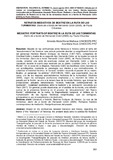Retratos mediativos de Beatriz en la ruta de las tormentas: diario de a bordo de Hernando Colón (2005), de Paula Cifuentes

Visualizar/
Data
2021-04-21Palabras Clave
Literatura e historia, Beatrice Enríquez de Harana, La ruta de las tormentas: diario de a bordo de Hernando Colón (2005), Romance histórico contemporáneo de mediación, Resignificaciones del pasadoLiterature and History, Beatriz Enríquez de Harana, La ruta de las tormentas: diario de a bordo de Hernando Colón (2005), Contemporary historical novel of mediation; Re-meanings of the past
Metadatos
Mostrar registro completoResumo
Basado en las confluencias entre literatura e historia sobre el tema del "descubrimiento" de América, este artículo pretende abordar la resignificación ficcional del personaje histórico Beatriz Enríquez de Harana (1467-1521), compañera de Cristóbal Colón y madre de su segundo hijo, Hernando Colón, en la novela La ruta de las tormentas: diario de a bordo Hernando Colón (2005), de Paula Cifuentes. En la novela, tenemos una serie de aventuras vividas por Hernando Colón y toda la tripulación durante el cuarto viaje realizado por su padre, Cristóbal Colón, al "Nuevo Mundo". En el curso de la diégesis, Hernando Colón se manifiesta como narrador en voz autodiegética, revelando su psicología, sus miedos y sus contradicciones. Al subjetivar el material histórico, el narrador también recuerda el pasado de su madre, Beatriz, un personaje “ex-céntrico” (HUTCHEON, 1991), que experimentó, muy de cerca, uno de los mayores acontecimientos históricos de la humanidad. Cifuentes (2005), según las estrategias escriturales empleadas y su intención de releer el pasado por la ficción, se une a la tercera fase de la novela histórica, que incluye las producciones actuales denominadas “novelas históricas contemporáneas de mediación”, modalidad mediadora entre la tradición y la renovación concebida por Fleck (2017). En general, puede observarse, en el análisis de la novela, una reflexión acerca de la presencia femenina en el proceso de “descubrimiento” del “Nuevo Mundo”, utilizándose de la ironía, la fragmentación temporal, el énfasis en la humanización de las figuras históricas resignificadas, que se configuran, principalmente, por el escepticismo y la desilusión.
Colecciones
Información Adicional
| Otros Títulos | Mediative portraits of Beatriz in la ruta de las tormentas: diario de a bordo de Hernando Colón (2005), by Paula Cifuentes |
| Correo Electrónico | fermenta@ula.ve / humanic@ula.ve amandamaria.elsner@gmail.com anamariaklock@hotmail.com |
| ISSN | 07983069 |
| Resumen en otro Idioma | Based on the confluences between literature and history, regarding the theme of the “discovery” of America, the present study aims to adress the ficctional reframing of the historical character Beatriz Enríquez de Harana (1467-1521), companion of Christopher Columbus and mother of his second son, Hernando Columbus, in the novel La ruta de las tormentas: diario de a bordo de Hernando Colón (2005), by Paula Cifuentes. In the novel, there are a series of adventures lived by Hernando Columbus and the entire crew during the fourth trip held by his father, Christopher Columbus, to the “New World”. In the diegisis, Hernando Columbus is an autodiegetic narrator who reveals his psychology, fears and contradictions. By subjectivating the historical material, the narrator also rememorates the past of his mother, Beatriz, an “ex-centric” character (Hutcheon, 1991), who experienced, very closely, one of the greatest historical events of humanity. Based on the writing strategies handled by the author and her intention in re-meaning the past through fiction, Cifuentes (2005) joins the third fase of the historical novel in which the current productions are called “contemporary historical novel of mediation”, a mediating modality between tradition and renewal formulated by Fleck (2017). In the analysis of the novel, it can be read a reflection on the female presence in the process of the “discovery” of the “New World” by the use of irony, temporal fragmentation, the emphasis on the humanization of resignified historical characters, which are mainly shaped by skepticism and disillusionment. |
| Colación | 361-380 |
| Página Web | www.saber.ula.ve/fermentum |
| País | Venezuela |
| Institución | Universidad de Los Andes |
| Sección | Fermentum: Dossier |





